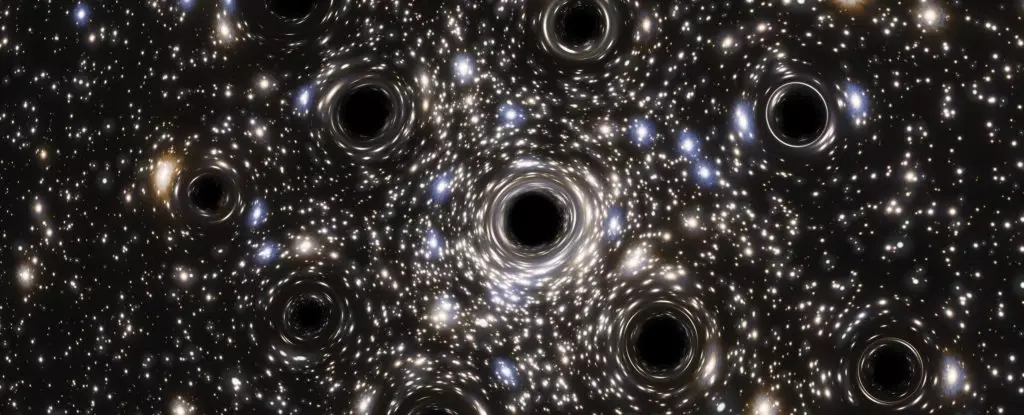In the vastness of the cosmos, few astronomical phenomena are as tantalizing as stellar clusters. Among them is Palomar 5, a remarkable globular cluster that stretches across an astonishing 30,000 light-years, residing approximately 80,000 light-years from Earth. This fluffy cluster of stars, reminiscent of a cosmic tapestry, may hold within its heart a staggering secret: a hidden population of over 100 stellar-mass black holes. As researchers delve deeper into the nature of such clusters, Palomar 5 emerges as a vital subject for understanding the intricate dynamics of star formation, evolution, and the elusive nature of black holes.
Globular clusters, often referred to as the “fossils” of the universe, encapsulate remnants of the early cosmos. Each cluster typically contains between 100,000 and 1 million ancient stars that formed simultaneously from the same primordial gas cloud. The Milky Way is home to around 150 known globular clusters, which serve as celestial laboratories for studying the history of the universe and the distribution of dark matter within galaxies. However, the emergence of tidal streams—long, slender arcs of stars—has captured the attention of astronomers, leading to groundbreaking explorations of their formation and implications.
Tidal streams pose intriguing questions regarding their origins. Unlike globular clusters, these streams often lack associated stellar systems, complicating research on their genesis. The advent of the Gaia space observatory, dedicated to mapping the Milky Way with unparalleled precision, has illuminated many of these streams, allowing scientists to perceive the cosmos in a new light. Astrophysicist Mark Gieles emphasizes this opportunity, remarking that studying streams linked to identifiable stellar systems can unlock critical insights into how these cosmic phenomena originated.
Palomar 5 stands out as a unique astronomical entity, presenting both a broad distribution of stars and an elongated tidal stream that spans more than 20 degrees of the night sky. Captivated by its distinctive qualities, Gieles and his team focused their research on this cluster, employing intricate N-body simulations to recreate the complex orbits and evolutionary paths of its constituent stars. This method allowed them to extrapolate the dynamics at play in Palomar 5, particularly in light of recent revelations suggesting that stellar-mass black holes may inhabit the centers of globular clusters.
The integration of black holes into their simulations revealed compelling findings. The interaction between stars and black holes leads to gravitational perturbations that can eject stars from their origins and contribute to the formation of tidal streams. Notably, the researchers discovered that the number of black holes within Palomar 5 significantly surpasses previous estimates. Their calculations indicated that there may be roughly three times more black holes than what would typically be predicted based on the total stellar population of the cluster. Astonishingly, this implies that black holes constitute over 20 percent of the cluster’s total mass.
These black holes, with masses averaging about 20 times that of our Sun, formed after supernova explosions during the cluster’s formative years. This revelation sets the stage for long-term consequences, as simulations suggest that Palomar 5 is on a trajectory toward dissolution, with its remaining members eventually becoming a stellar stream of predominantly black holes. Such a scenario not only offers insight into the fate of Palomar 5 but also raises questions about the ultimate destiny of other globular clusters.
The implications of these findings extend far beyond Palomar 5. Researchers posit that other globular clusters will likely undergo similar fates, transforming into stellar streams over billions of years. This process will unveil new avenues for understanding black hole dynamics and impending mergers, particularly the elusive category of middleweight black holes that challenge existing astrophysical models.
As Fabio Antonini from Cardiff University observes, a considerable fraction of binary black hole mergers are believed to occur within star clusters. However, the true extent of black hole populations in such clusters remains elusive, primarily due to observational challenges in detecting these dark entities. Understanding the dynamics of clusters like Palomar 5 will ultimately refine our comprehension of black hole formation, evolution, and their role in the cosmic landscape.
The study of Palomar 5 provides a remarkable glimpse into the complexities of stellar clusters and the hidden dynamics at work within the universe. As astronomers continue to unravel the mysteries locked within these luminous collections of stars, we inch closer to understanding the intricate relationships between stars and black holes, offering a richer narrative of our cosmic origin and the processes that shape the universe as we observe it.

